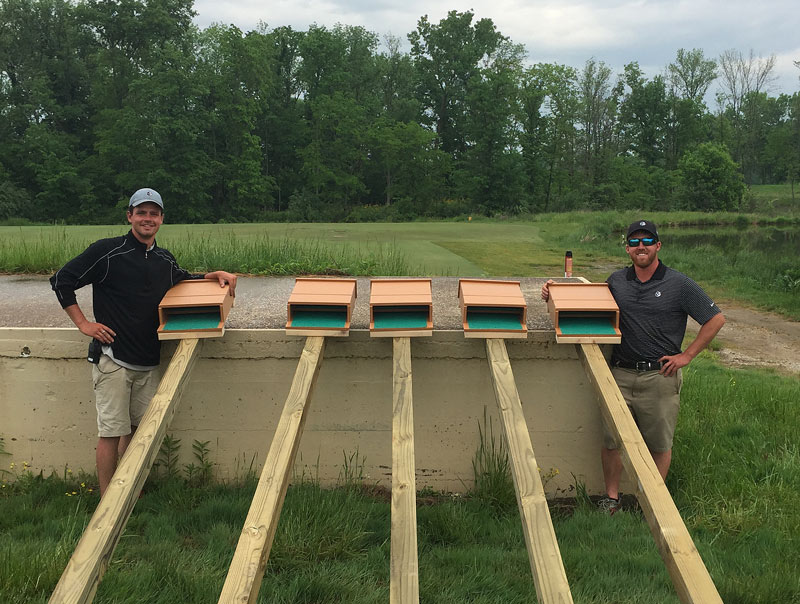
Bringing in the bats: Victoria National Golf Club intern Dylan Creighton (left) and irrigation technician Casey Underwood with the course’s five bat houses ready to be stationed last summer. Photo courtesy of Seth English
As summer descends, so too do swarms of biting, bothersome insects to the muggy transition zone climate of Newburgh, Ind., home of Victoria National Golf Club, an 18-hole private course that unfolds on 418 acres of reclaimed mining land. To combat the uncomfortable quantities of mosquitoes and gnats that bombard both maintenance crew and golfers, assistant superintendent Seth English has set about harnessing the appetite of nature’s most effective predator of flying insects: bats.
“We had a really awful insect problem, and we knew there were bats in the area that could control the mosquitoes and gnats, for the comfort of the golfers and the convenience of the staff,” says English, who had seen the strategy of establishing bat houses for natural pest management employed successfully at other golf facilities. When he arrived at Victoria National in 2014, English proposed the approach to director of agronomy Kyle Callahan.
For curbing insect populations, bats are an environmentally sound alternative to practices such as fogging the golf course, so the plan was a perfect fit for Victoria National. “In today’s industry, throwing a pesticide into the air to reduce insects isn’t acceptable — it’s dangerous and expensive,” says English, a five-year member of GCSAA. “So we went with the more realistic idea of doing it naturally.”
Naturally and quite efficiently, in fact. According to Rob Mies, executive director of the Organization for Bat Conservation, a Michigan-based nonprofit that provides national educational programming on these oft-misunderstood mammals, a single bat consumes 2,000 to 5,000 insects per night, and their diet includes mosquitoes, gnats, moths and beetles. “The ecological role of bats in the U.S. alone is estimated at saving upward of $50 billion annually, all just from their pest control,” Mies says.
In exchange for their superb insect-reduction services, bats benefit from being welcomed to land in the vicinity of golf courses, which typically offers the tree-rich and forest- or field-edged environment the creatures prefer in the wild. North American bat populations are currently imperiled by habitat destruction, as well as by a fatal fungal condition unique to bats that’s known as white-nose syndrome, says Mies. In addition, a bat mother has only one offspring per year, rendering these nocturnal fliers slow to repopulate.
Bat houses furnish much-needed roosting habitat, a safe haven from the elements and predators, and a sanctuary for bats to raise their young. “By providing bat houses, we help stabilize local bat populations, and hopefully increase them to keep bats around,” says Mies. The bats, in turn, take a bite out of bug levels. “And the bats handle all of that for free,” Mies adds.
Bat houses consist of a single or multiple internal chambers, or “cells.” The number of chambers isn’t critical, although houses split into more chambers tend to accommodate more tenants. Bats enter from beneath and pack in tightly — just one standard-sized bat house can hold approximately 250 bats. Mies says an ideal bat house is made of untreated wood and is at least 2 feet tall and 16 inches wide, positioned on a pole at least 15 feet high. The site should receive at least four hours of direct sunlight and have a minimum of 20 open feet in front of the bat house.
Last summer, Victoria National, which is a Certified Audubon Cooperative Sanctuary, purchased and installed five triple-chamber bat houses, located on 20-foot posts in out-of-play areas throughout the property. Because the bats go about their work while the golf course is asleep, they do not disturb members or staff, English says. While the precise total of insects exterminated is difficult to determine — according to Mies, bats normally find a house the first summer it exists, then colonize it during the second summer — a slow decline in their populations was already apparent to English by fall 2015. And with the bat houses costing just under $900 (including labor), English says the project is a fairly inexpensive one for any facility.
Curious whether bats could assist around your course? Bats are common throughout the United States and Canada, and nearly all North American bats are insect eaters and share the same dwelling needs, so they can be summoned for pest patrol duties via properly constructed and sited bat houses. Essentially, anywhere there’s a food source for them, you’ll find bats, conducting their insect-devouring activities underneath the curtain of night. For more information on bats and bat houses, including free plans for building your own, go to the Organization for Bat Conservation website.
Megan Hirt is GCM’s managing editor.